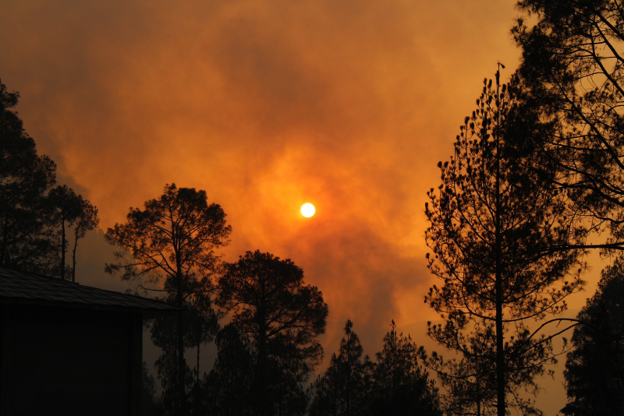What Fire Resistant Roofing Products Are Best?
According to the National Fire Protection Association (NFPA), over 58,000 fires burned around nine million acres of U.S. land in 2018. Within those nine million acres, 18,137 homes and 229 commercial structures were destroyed, with the highest number of lost properties occurring in California.
Due to the large number of wildfires and lost structures, an increasing emphasis has been put on creating fire-safe home and building design. Fire-resistant roofing is one material that homes in wildfire-damage-prone states, such as California and Nevada, are required to have. But, there are several different fire resistant roofing materials to choose from. Here is a guide to the various fire-resistant roofing materials that are available and what’s genuinely best for creating wildfire-resistant homes.
Why Choose Fire-Resistant Roofing?
States like California, Nevada, New Mexico, and even Colorado are prone to wildfires due to the dry weather that sometimes occurs, especially during the summer months. Because of this, the United States Forest Service created the Wildland-Urban Interface (WUI) Code. According to the Forest Service, the WUI is the area where residential homes and wildlands meet and is designed to help reduce the risk of wildfire spread from forest to human-filled areas.
One of the measures the WUI takes to prevent the spread of wildfires is by evaluating and specifying the use of certain kinds of building products for residential and commercial properties. Fireproof roofing materials are one such product—they can significantly impede the spread of wildfires and protect urban environments from more severe devastation. WUI-approved fireproof roofs are resistant to the entry of fire embers and fire radiation, and are also resistant to ignition in the case of a wildfire.
Fire-Resistant Roofing Materials
Asphalt
Asphalt shingles are a standard roofing option seen on homes everywhere, but they are also one of the many fire-resistant roofing materials available on the market. Unlike wood shingles, asphalt shingles can last two hours in a fire before catching, making them a fairly fire-resistant material that is also extremely affordable.
However, asphalt shingles are not without their flaws, and they are not the best option in states like California, where homes are prone to severe wildfire damage.
Concrete and Clay Tiles
While not as common throughout the country, concrete and clay tiles are another fire-resistant option that some builders and homeowners turn to in certain parts of the country. Aside from fire protection, options like clay tiles can also provide homes with a unique Spanish or Mediterranean look. However, both concrete and clay tiles come at a cost. They can be a little more expensive to install and maintain, can require periodic replacing, and add extra weight on the top of a home. As a result, the home may require additional structural support to support the roof, otherwise it could cause the whole home to collapse in on itself.
Slate
Another fire -resistant roofing option that is on the heavier side is slate tiles. Like concrete and clay roofing tiles, slate tiles may require added structural support so as not to collapse the home. They offer the same high level of fire resistance as other roofing options of the list, with the added benefit of natural beauty. Beyond that, slate roofing tiles are virtually indestructible in many different ways as well, making them one of the more durable roofing options available.
Metal
For a lighter option in fireproof roofing materials, there is metal roofing. Metal roofs come in a variety of different alloys, including zinc, copper, steel, stainless steel, and a range of other metal materials. These offer a lightweight, non-corrosive roofing option that is great for creating wildfire-resistant homes across the country.
Another benefit to metal roofing is the wide range of available styles. Metal roofs can be sheets or shingles, come in a variety of colors, and can even be fashioned to look like wood or stone for a truly unique look.
Synthetic
Finally, there are synthetic roofing shingles, which use eco-friendly materials like polyurethane. Synthetic shingles are a cost-effective option that provides strength, durability, and most importantly, fire resistance. Like metal roofing, synthetic roofing comes in a wide range of style and color options, making it an incredibly versatile roofing option that will work on any home.
Which Is Best for Wildfire-Resistant Homes?
With so many fire-resistant roofing materials available, it can be challenging to know which one is the best choice. As mentioned before, many states have to follow special building codes that indicate what type of products can and cannot be used for building or remodeling homes. Parts of California, for instance, require homes to be equipped with Class A Fire Rating Roofs.
Synthetic shingles, like those offered by CeDUR, provide the perfect combination of aesthetics, safety, and durability. These lightweight, polyurethane roofing shakes offer a Stand Alone Class A Fire Rating, approved for even the strictest California county building codes.
CeDUR’s shingles are one of the only fire-resistant roofing materials that do not need a special fire-resistant underlayment. They are also the only fire-rated roofing material that can self-extinguish flame spread, earning it WUI approval. Beyond that, CeDUR's shingles have a beautiful, cedar-molded appearance. This allows homeowners to have the look of real wood shakes, without the worry of them catching on fire or becoming damaged from strong winds or impacts.
Preventing wildfire damage is a critical task, especially with wildfires becoming more common across the county, and particularly along the West Coast. States, counties, and even organizations like the United States Forest Service have begun setting clear rules and guidelines on how to best prevent the spread of wildfires. These guidelines aim to minimize the devastation wildfires can cause in urban, human-dense areas.
Investing in fireproof or fire resistant roofing materials is one way to help reduce the risk of spreading wildfires and wildfire damage, and it makes a significant difference. Fire-resistant roofing, like CeDUR’s highly durable synthetic roofing shakes, is one important step in creating perfect wildfire-resistant homes.




